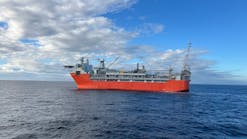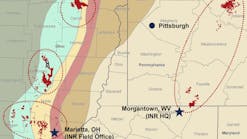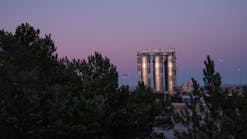Robert G. Worthingham, Benjamin Asante, Gary A. Carmichael, Terese Dunsmore
NOVA Corp. of Alberta Calgary
A study of the effectiveness of internal coatings in enhancing the flow efficiency of high-pressure gas pipelines has led NOVA Corp. of Alberta, Calgary, to coat internally 95 miles of 48-in. pipe during 1994-95.
NOVA estimates that the project could result in a savings to its customers of nearly $2.8 million (Canadian) over the economic life of the facilities.
The study's objective was to obtain data for realistic pipeline simulations for evaluating the economics of coating used to enhance flow efficiency.
The study measured the internal roughness of coated and bare pipes whose age spanned from I week to 32 fears to examine fouling effects and estimate the representative or typical roughness.
Fouling occurs when particulates build up on the pipe's surface and begin to constrict flow.
A representative value of surface roughness for new internally coated pipe was determined to be 250 m-in. (m-in. = 10-6 in. = 0.000001 in.) A conservative (high) value of surface roughness for new bare pipe was determined to be 750 m-in..
The study also found that significant deterioration of the surface roughness of bare pipe occurs during storage before construction.
A cost-sensitivity portion of the study showed that, at moderate-to-high flow rates in 36-in. pipelines, net benefits for NOVA are derived from use of internal coatings when fuel-gas prices exceed $1/Mscf.
TASK FORCE FORMED
NOVA Corp. of Alberta is a major Canadian pipeline and petrochemical company with more than 11,700 miles of gas-transmission lines. The company's NOVA Gas Transmission Division, formerly the Alberta Gas Transmission Division, transports about 75% of marketed Canadian natural-gas production and more than 15% of the natural gas produced annually in North America.
Internal pipeline coatings have been marketed historically as being able to improve flow efficiency through reduced operating costs with lower internal roughness (drag) and reduced fouling.
Internal coating also offers protection against corrosion caused by atmospheric oxidation during storage and the presence of corrosive components in the transported material.
Coated pipes are also easier to inspect for defects such as dents, cracks, quench marks, and weld undercuts, which might result in catastrophic failure of the line if undetected. The coating makes defects more visible.
Other advantages include ease of pigging and prevention of odorant adsorption on the internal surface of the pipe.
The cost effectiveness of internally coating pipelines depends on the relative magnitude of the internal roughness and flow volumes. Uncertainty exists within industry as to the appropriate roughness values to be used in the planning, design, and operation of pipeline systems.1
Discussions with five major pipeline companies in North America revealed they had no economic justification for use of internal coatings. Those that used internal coatings did so because they felt it was "good practice."
Clarification of this uncertainty would allow sound economic and technical decisions on the use of internally coated pipe by having available reliable data on internal pipe roughness for the simulation models used in planning as well as data on the change in pipeline flow efficiency due to fouling effects.
To investigate the effectiveness of internal pipeline coating, NOVA established a task force whose technical objective was to consolidate and analyze technical and economic information relevant to internal pipeline coating, field flow testing methods, and system performance.
A secondary objective was to review the scientific literature with respect to these pipeline efficiency considerations, to identify opportunities for reducing drag, and to determine the need for further research.
ECONOMIC REVIEW
The procedure used in evaluating the benefit of internal coatings for specific projects has been documented.2
At high flows, the transmission factor is dominated by the surface roughness; at low flows, however, the transmission factor is relatively independent of surface roughness because the laminar boundary layer acts as a "smooth" surface.
The decision for use of internal coatings is case specific and depends on both physical (forecast flow rates, pipeline diameter, location, and terrain) and economic (materials, construction, operating and fuel costs of the proposed facilities, discount rate, interest rate, and capital deployment) factors.
One of the key inputs into this analysis is surface roughness, which is related to the transmission factor used in the pressure flow equations shown in the accompanying box.
The compressor fuel consumption was evaluated by use of the pressure-flow, axial temperature and compressor equations. Fig. 1 shows the economic analysis performed.
The cumulative present value cost of service (cpvcos), which includes capital and operating costs, over 35 years for 30-mile lengths of pipeline are compared for the different scenarios considered.
The cpvcos reflects the time value of money and offers a basis for comparing alternatives with capital and operating costs occurring at different times over the life of a pipeline.
The cpvcos is defined as shown in the accompanying box.
As may be seen from Fig. 1, the decision for internally coating pipelines depends strongly on the roughness value selected.
Assumed roughness values of 400 m-in. for internally coated pipes and 650 m-in. for bare pipes have been used in the past. These values have since come into question.
To provide cost-effective facilities to NOVA's customers, the internal roughness investigation was essential.
An analysis was performed to determine the sensitivity of the "cost of service" calculations to changes in fuel-gas pricing.3 The results of the analysis are shown in Table 1.
Net benefits from the use of internal coatings, the analysis showed, could be obtained in 36-in. pipelines as long as moderate-to-high flows were anticipated and the fuel-gas price was at least $I/Mscf.
For 36-in. pipelines with low flow rates, fuel-gas costs from $4 to $6/Mscf were required for a net benefit from the use of internal coatings.
FLOW TESTING
The task force reviewed 100 historical flow tests performed in Alberta Gas' system and determined there was either insufficient data or too many variables to permit reliable analysis.1
This was primarily due to the complexity of the pipeline network, system transients, insufficient main line telemetry, and looped line considerations (all crossovers open).
It was determined that with current flow testing methods, comparative flow tests would be most accurate for looped pipelines with open crossovers (at the beginning and end of the test section only) or if the test results are compared to previous tests performed on the same pipeline.
This would reduce errors introduced by such things as differences in elevation, length, and curvature. It was decided a more successful approach was to measure stock pipe and hot tap coupons from the pipeline system to determine the roughness which would be expected for coated and bare pipeLines as well as to observe any evidence of fouling.
The method for measuring surface roughness has been described.1 4
The initial roughness of "new" pipe is affected by the amount of time the pipe has been stored before construction. Transcontinental Gas Pipeline Co. found that significant deterioration of the surface roughness of bare pipe occurred during storage (Fig. 2).5
Coated pipe showed minimal deterioration in the same study.
In order to confirm this finding, bare pipe was tracked. Internal roughness of the pipe was measured periodically from fabrication of the pipe until construction.
Roughness increased from a maximum of 175 m-in. in the pipe mill to 500 m-in. after 80 days of storage. The average roughness after 80 days was 350 m-in. (Fig. 3a). Internally coated pipe was monitored for roughness changes during storage immediately after coating. No trend in deterioration was observed in this pipe over 20 days of storage.
The internal roughness of the internally coated pipe maintained a mean value of 125 m-in. (Fig. 3b). This appears to confirm Transco's observations that the roughness of bare pipe increases during storage and that the roughness of coated pipe remains relatively constant.
FOULING; ROUGHNESS
Hot-tap coupons removed from Alberta Gas' system between 1989 and 1992 were measured to determine the range of roughness experienced.
Separating coated from bare coupons and plotting the measured roughness vs. years of service for each pipeline sampled allowed inferences about the early condition of pipelines and the amount of fouling experienced.
Fig. 4a shows a definite fouling trend for coated pipe. The maximum roughness for coated pipe appears to increase from 150 m in. when new to 400 m-in. after 20 years of service.
Fig. 4b shows the wide scatter and lack of apparent fouling trend found for bare pipe. The maximum roughness for bare pipe appears to remain at approximately 750 m-in. regardless of service life. Severe scaling in two cases was found, however, where the roughness ranged from 7,000 to 35,000 m-in.
This apparent scatter was due to the wide variation in initial roughness for bare pipe caused by the pipes undergoing different amounts of storage prior to construction.
Undoubtedly, some fouling effects occur with the bare pipe, but they are strongly masked by the variation in initial roughness.
The roughness values measured from the hot tap coupons were "Ra" or sand grain roughness; whereas, Ke or effective roughness is used in simulation models. AGA has stated that in fully turbulent flow regimes, Ra equals Ke.1
If this is indeed the case, then the flow simulation model used should be revised more closely to reflect the measured Ra sand-grain roughness for coated and bare pipe.
In order to confirm this relationship, the task force, using supervisory, control and data acquisition (scada) data on flow rates and pressures, performed simulations of a 42-in. internally coated pipeline which had been in service for 12 years.
The simulation showed an effective roughness of 160 m-in, which is well within the range of Ra measurements shown in Fig. 5 for pipelines of similar age.
RE-ANALYSIS
Initial analysis of the hot-tap coupon and stored pipe data suggested the expected difference between the measured roughness for coated and bare pipe was closer to 700 m-in. rather than the 250 m-in. previously used.
In order to examine the sensitivity of the current model to input surface roughness values, three projects were reviewed to determine how the construction recommendations would have changed if different input values were used for internal roughness.
Since fouling over the life of the pipeline is not accounted for in current models, the values for new pipe were used for the life of the pipeline.
Table 2 lists the projects considered and some key parameters for each project. Table 3 shows the results of the analysis.
The original analysis indicated that internal coating was not cost effective fL)r these three projects.
Using two variations of the estimated 700 m-in. difference between coated and bare pipe (200/900 and 300/1,000 m-in.) showed, however, that all three projects would have been recommended as candidates for internal coating had either of these alternate roughness sets been used.
The study reached the following conclusions:
- A representative value of surface roughness for new coated pipe was determined to be 250 m-in.
- A conservative (high) value of surface roughness for new bare pipe was determined to be 750 m-in.
- Significant deterioration of the surface roughness of bare pipe occurs during storage before construction.
- A cost-sensitivity study has shown that at moderate-to-high flow rates in 36-in. pipelines, net benefits are derived from the use of internal coatings when fuel-gas prices exceed $1/Mscf.
Implementation of the 250-750 m-in. effective roughness for coated and bare pipe, respectively, in the analysis of requirements for the 1994-95 gas year resulted in the recommendation to coat internally 95 miles of 48-in. pipe.
Analysis for all proposed facilities has shown that internal coating is at present economically, justified in the AGTD system on large diameter pipelines expected to experience moderate-to-high flow rates.
REFERENCES
- Worthingham, R., et al., "Pipeline Efficiency Study, Interim Report 1989," NOVA Mechanical and Materials Engineering, June 1990.
- Uhl, A.E., et al., "Steady Flow in Gas Pipelines," Institute of Gas Technology Report No. 10, American Gas Association, July, 1965.
- Worthingham, R., et al., "Pipeline Efficiency Study, Summary Report," NOVA Mechanical and Materials Engineering, February 1993.
- Worthingham, R., et al."Pipeline Efficiency Study, Interim Report 1990," NOVA Mechanical and Materials Engineering, December 1991.
- Crowe, R. H., "What Transco learned about internal coating of gas pipelines." OGJ, Apr. 6, 1959, P. 108.
Copyright 1994 Oil & Gas Journal. All Rights Reserved.


